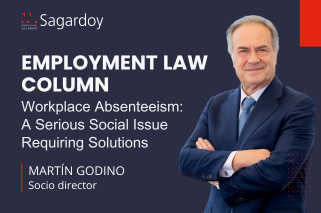The issues afflicting our labor market since the Spanish Transition are well-known: high unemployment rates; duality in our labor market due to a high temporary employment rate; precariousness in certain productive sectors; stagnation of labor conditions; excessive costs at the start, during, and at the termination of employment contracts; judicialization of labor relations; and, finally, the excessive number of small employers, which hinder greater stability in employment.
Since the beginning of democracy, the different governments of the nation, regardless of their political affiliation, have shared the diagnosis of a poorly functioning labor market and have, with varying degrees of intensity, implemented labor law reforms.
Some of these reforms, recall, were agreed with social agents (such as those in 1997 and 2006), attempting to address each of the aforementioned issues, such as easing temporary contracts to encourage employment (late 1980s), promoting collective bargaining to adapt business situations to economic fluctuations (late 1990s), or reducing labor costs (also in the late 1990s and more recently).
However, the true turning point in the regulatory framework of labor relations came with the 2010 and 2012 Reforms. It was then that a new path was first embarked upon, “the European way,” betting on the institutionalization of “flexicurity” mechanisms that have been so successful in neighboring countries: internal flexibility for companies to use alternatives to dismissal (as had been traditional in our country) during times of crisis, while simultaneously ensuring necessary social protection and guarantees for workers in a flexible labor relations framework.
Since then, the impacts of economic changes have been minimized, preventing the massive destruction of jobs that had occurred in the past, and advocating for the modification of conditions, whether individual or collective, which, though traumatic in some cases, preserve the employment contract (such as the recent example of ERTEs) and, more importantly, generate confidence in job creation and business growth, in a virtuous circle that has enabled Spain to experience labor growth during difficult times in recent years.
Now, from a more “ideological” perspective, the repeal of that 2012 Labor Reform has been announced almost since its approval, without analyzing its real impact on the labor market, either due to the perverse application of the approved regulations or a judicial interpretation that raised doubts about the drafting of a law that was clearly innovative in our country.
The benefits in employment and attracting investment are indisputable, supported by a large number of national and international studies. But, naturally, an evaluation was necessary to later correct the more negative results in labor relations arising from such far-reaching reforms.
This is undoubtedly the responsibility of the government and social agents. Finally, after much back-and-forth, several announcements, and an exercise in fulfilling the duty, this is what has happened: a correction of labor law, with no substantial changes, mostly consolidating the 2012 Labor Reform but seeking areas for improvement in institutions (some of which were not addressed by that Reform) in areas such as recruitment, collective bargaining, outsourcing of services, and innovative internal flexibility mechanisms (such as the new RED system).
The outcome, following intense and time-pressured negotiations, could only be one derived from a tripartite agreement that has been consolidated into a Royal Decree, recently validated by Parliament, not without controversy. We are facing a prudent and moderate reform, far from the extremes announced several months ago, and which, I insist, maintains the core of the previous reforms in the area of “flexicurity.” Pragmatic in form and content.
From here, it will be necessary to wait and see whether what has been approved will have positive effects, improving the employment problems, particularly in the area of temporary contracts, where the commitment has been far greater than in other areas. The effects will not be visible in the short term because the dynamics of labor relations, the way companies and trade unions operate, do not change abruptly unless there are profound changes, which is not the case here. Therefore, it will be necessary to evaluate and correct what is necessary.
Beyond this regulatory “correction,” an opportunity has once again been missed to create a more modern framework for our labor relations system, one that requires less regulation and greater prominence for collective bargaining, given the maturity of our labor model; to give more importance to new forms of work; to encourage business growth; to innovate in hiring with models similar to the “Austrian backpack”; and to focus more on active employment and training policies than on labor regulations, which are already dense and complex for many businesses. With deeper and more thoughtful reflection, free from ideological bias (employment knows no ideology), and with the collaboration of all involved parties, we will gradually move away from our reputation as a country with high unemployment rates.



